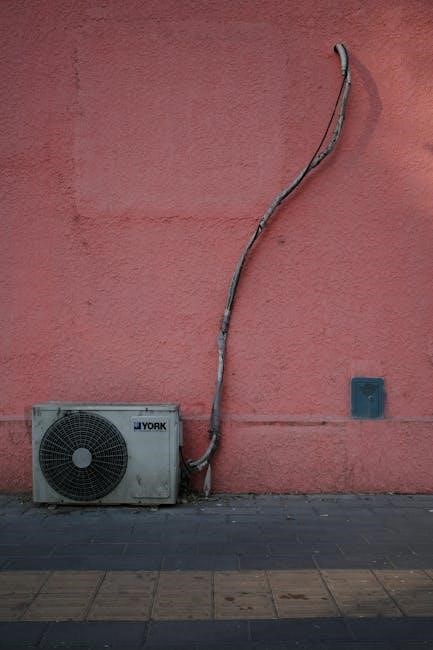The Honeywell FocusPRO 5000 Series offers a non-programmable, digital thermostat solution designed for simplicity and energy efficiency, compatible with various HVAC systems and heat pumps, supported by a comprehensive installation guide.
1.1 Overview of the Honeywell FocusPRO 5000 Series
The Honeywell FocusPRO 5000 Series is a non-programmable digital thermostat designed for simplicity and energy efficiency. It is compatible with a wide range of HVAC systems, including conventional and heat pump configurations. The series includes models like the TH5110D, TH5220D, and TH5320U, offering reliable temperature control for residential and light commercial applications. With a user-friendly interface and built-in features like compressor protection, it provides consistent performance while minimizing energy waste, making it a versatile choice for homeowners seeking a straightforward thermostat solution.
1.2 Key Features and Benefits
The Honeywell FocusPRO 5000 Series thermostats offer key features such as non-programmable digital control, compatibility with conventional and heat pump systems, and built-in compressor protection to prevent damage. They provide precise temperature control, energy efficiency, and a user-friendly interface. Additional benefits include optional battery backup, easy installation, and compatibility with Honeywell zoning panels. These features make the series a reliable and cost-effective solution for maintaining consistent indoor comfort while optimizing energy usage.
Pre-Installation Requirements
Before installation, ensure system compatibility, prepare necessary tools, and verify electrical setup to guarantee a smooth and successful installation process for the Honeywell 5000 Series thermostat.
2.1 System Compatibility Check
To ensure proper functionality, verify that the Honeywell 5000 Series thermostat is compatible with your HVAC system. Check if it supports conventional heating/cooling systems or heat pumps, and confirm compatibility with your system’s stage configuration (e.g., 1-stage, 2-stage, or multi-stage). Additionally, verify if your system requires special wiring or configurations, such as emergency heat or auxiliary settings. This step is crucial to avoid installation issues and ensure optimal performance.
2.2 Tools and Materials Needed
For a successful installation, gather the necessary tools and materials. Required tools include a screwdriver (flathead and Phillips), wire strippers, pliers, and a voltage tester. Ensure you have the wallplate, mounting screws, and wall anchors provided with the thermostat. Additional materials like drywall anchors may be needed for uneven surfaces. Verify the wiring matches your system’s requirements, and ensure power is turned off before starting. This preparation ensures a smooth and safe installation process.

Wallplate Installation
Begin by separating the wallplate from the thermostat and positioning it on the wall. Ensure proper alignment and secure mounting using the provided screws and anchors.
3.1 Removing the Wallplate
To remove the wallplate from the Honeywell FocusPRO 5000 Series thermostat, start by detaching it from the main unit. Gently pull the wallplate away from the thermostat body to release it from its mounting clips or screws. Ensure the wires remain connected to the thermostat during this process. If the wallplate is secured with screws, carefully remove them using a screwdriver. Once detached, set the wallplate aside for mounting. Avoid forcing the wallplate to prevent damage to the wiring or thermostat.
- Gently pull the wallplate away from the thermostat body.
- Remove any screws securing the wallplate if applicable.
- Handle wires carefully to prevent disconnection or damage.
3.2 Mounting the Wallplate
Mount the wallplate by positioning it on the wall, ensuring proper alignment with screw holes. Pull wires through the wire hole and secure the wallplate using screws provided. Tighten screws firmly to hold the wallplate in place. Verify the wallplate is level and securely fastened to the wall. Avoid over-tightening to prevent damage to the wallplate or surrounding area. Ensure all wires remain connected and organized during the mounting process.
- Position the wallplate on the wall, aligning screw holes.
- Guide wires through the wire hole and secure with screws.
- Tighten screws to ensure stability without over-tightening.
- Check that the wallplate is level and firmly attached.

Power Options and Wiring
The Honeywell 5000 Series thermostats support both battery and AC power options. Wiring varies for conventional HVAC and heat pump systems, requiring precise connections for proper functionality.
- Battery-powered models provide backup during power outages.
- AC-powered models require direct wiring to the HVAC system.
- Ensure correct wiring to avoid system malfunctions.
4.1 Understanding Power Requirements
The Honeywell 5000 Series thermostats require either battery or AC power. Battery-powered models use 2 AA alkaline batteries, providing backup during outages. Hardwiring is optional for AC power, ensuring continuous operation without battery reliance. Choose the power option that suits your system needs, ensuring compatibility and reliability for optimal performance. Proper power setup is crucial for thermostat functionality and system efficiency.
- Battery-powered: Offers backup during power outages.
- Hardwired: Provides constant power for reliable operation.
4.2 Wiring Conventional HVAC Systems
For conventional HVAC systems, connect the thermostat to the appropriate terminals. Typically, wire the R (power), W (heat), Y (cool), G (fan), and C (common) terminals. Ensure the system is turned off before wiring. Follow the color-coded diagram in the manual for accurate connections. Double-check the wiring to prevent damage or safety hazards. Use the correct gauge wire for reliable operation. After wiring, test the system to ensure proper heating, cooling, and fan functionality.
4.3 Wiring Heat Pump Systems
For heat pump systems, connect the thermostat to the appropriate terminals. Typically, wire the R (power), W (heat), Y (cool), G (fan), and C (common) terminals. Use the O or B terminal for heat pump reversing valve control. Ensure the system is turned off before wiring. Follow the manufacturer’s wiring diagram for specific heat pump configurations. Double-check connections to avoid damage or malfunctions. After wiring, test the system to ensure proper heating, cooling, and heat pump operation. Refer to the manual for detailed instructions on heat pump-specific wiring requirements.

Thermostat Mounting and Configuration
Mount the thermostat by removing the wallplate and securing it to the wall. Configure settings like system type, temperature range, and changeover modes to match your HVAC setup.
5.1 Mounting the Thermostat
Begin by removing the wallplate from the thermostat. Pull the wires through the wire hole and position the wallplate on the wall. Secure it using the provided screws. Ensure the wallplate is level and firmly attached. Once mounted, reattach the thermostat to the wallplate by aligning the tabs and gently snapping it into place. This ensures proper installation and functionality. Refer to the manual for specific screw placements and leveling guidelines to avoid installation errors.
5.2 Configuring Thermostat Settings
After mounting, configure the thermostat settings to match your HVAC system. Select the system type (heat pump or conventional) and choose between manual or auto changeover modes. Set the temperature range and differential to optimize performance. Enable compressor protection to prevent short-cycling. Adjust fan settings and ensure emergency heat options are configured if applicable. Refer to the manual for specific button sequences and feature customization to ensure proper operation tailored to your heating and cooling needs.
Special Functions and Features
The Honeywell 5000 Series includes features like compressor protection to prevent short-cycling and manual/auto changeover modes for flexible system operation, enhancing efficiency and user convenience.
6.1 Compressor Protection
The Honeywell 5000 Series includes a built-in compressor protection feature that prevents short-cycling by enforcing a minimum cycle time. This protects the compressor from excessive starts and stops, reducing wear and tear. The feature is automatically enabled and ensures the system operates efficiently while prolonging equipment life. During system testing, compressor protection can be bypassed to test the HVAC system without interference. This ensures safe and reliable operation, making it a key feature for maintaining system longevity and energy efficiency.
6.2 Manual/Auto Changeover Modes
The Honeywell 5000 Series offers manual and auto changeover modes for flexible system control. In manual mode, users can select between heating, cooling, or off. Auto mode automatically switches between heating and cooling based on temperature, optimizing comfort and energy use. The default setting is manual changeover, but auto mode can be enabled for convenience. These modes allow users to customize system operation according to their preferences, ensuring efficient and consistent temperature management throughout the year.
System Testing and Verification
After installation, run system tests to ensure proper operation. Verify heating, cooling, and fan functions. Compressor protection is bypassed during testing to prevent equipment damage.
7.1 Running Installer System Tests
To initiate system tests, press and hold the ‘S’ and ‘T’ buttons until the display changes. Use the ‘NEXT’ button to cycle through tests, and ‘DONE’ to exit. Tests include heating, emergency heat, cooling, and fan operations. Available tests vary depending on the thermostat and system type. Ensure all functions operate correctly, as compressor protection is bypassed during testing to prevent equipment damage. Follow on-screen prompts to verify system performance and ensure proper installation.
7.2 Verifying Heating, Cooling, and Fan Operations
After running system tests, verify each function: heating, cooling, and fan operation. Ensure heating activates when set to “HEAT,” cooling starts in “COOL,” and the fan runs in “ON” or “AUTO” modes. Test emergency heat if applicable. Check airflow for proper circulation and verify smooth transitions between modes. Compressor protection is bypassed during testing to allow continuous operation. Ensure all systems function correctly and adjust settings if necessary to achieve optimal performance and energy efficiency.

Technical Specifications
The Honeywell FocusPRO 5000 Series supports 1 Heat/1 Cool systems and heat pumps, requiring 20-30 VAC. It operates between 32°F to 90°F and 20%-80% humidity.
8.1 Compatible Systems and Models
The Honeywell FocusPRO 5000 Series is compatible with 1 Heat/1 Cool systems, including conventional HVAC systems and heat pumps. Models such as the TH5110D, TH5220D, and TH5320U are designed for 2-stage heating and cooling systems. These thermostats support single-stage and multi-stage configurations, ensuring flexibility for various home setups. Compatibility extends to systems requiring precise temperature control, making them suitable for both residential and light commercial applications. The series is optimized for efficiency and reliability across different HVAC configurations.
8.2 Electrical and Environmental Specifications
The Honeywell FocusPRO 5000 Series operates on 24V AC power, with some models offering battery backup options for continuous operation during power outages. Environmental specifications include an operating temperature range of 32°F to 90°F (0°C to 32°C) and a storage range of -20°F to 120°F (-29°C to 49°C). The thermostat is designed to function in environments with up to 80% relative humidity, ensuring reliability in various indoor conditions. These specifications ensure optimal performance across diverse installation environments.
Customer Assistance and Support
For assistance, contact Honeywell Customer Service at 1-800-468-1502 or visit their official website. Warranty details and support resources are available online, ensuring comprehensive customer care.
9.1 Contacting Honeywell Customer Service
For inquiries or support, contact Honeywell Customer Relations at 1-800-468-1502. In the U.S., write to 1985 Douglas Drive, Golden Valley, MN 55422. In Canada, contact Honeywell Limited at 35 Dynamic Drive, Toronto, Ontario M1V4Z9. Customer service is available to address warranty questions, installation issues, or product-related concerns. Refer to the installation manual for additional support options and regional contact details.
9.2 Warranty Information
The Honeywell FocusPRO 5000 Series thermostats are backed by a limited warranty covering defects in materials and workmanship for one year from the date of purchase. The warranty is non-transferable and applies to the original purchaser only. For details, refer to the installation manual or contact Honeywell Customer Service. Proper installation and adherence to guidelines are essential to maintain warranty validity. Exceptions and limitations apply, as outlined in the warranty section of the manual.
The Honeywell FocusPRO 5000 Series thermostat offers efficient, user-friendly climate control, ensuring reliable performance and energy savings. Proper installation and configuration guarantee optimal functionality and customer satisfaction.
10.1 Final Checklist for Successful Installation
- Ensure the wallplate is securely mounted and properly aligned.
- Verify all wiring connections match the system requirements.
- Confirm power options are correctly configured (battery or hardwired).
- Test heating, cooling, and fan operations for proper functionality.
- Enable compressor protection and manual/auto changeover modes as needed.
- Review technical specifications to ensure system compatibility.
- Check warranty information and register the product if required.
- Perform a final system test to ensure seamless operation.
This checklist ensures a smooth and efficient installation process for the Honeywell 5000 Series thermostat.